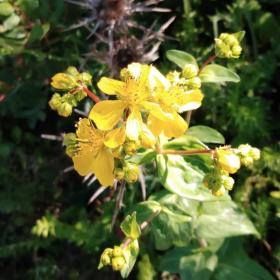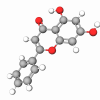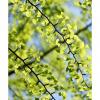Traditionally St. John’s wort (Hypericum perforatum) has been used as a remedy for many ailments: it is an anti-diarrheal (tannin content), diuretic (flavonoid content), liver tonic, and cleanser and is helpful in incontinence, gout, and rheumatism. However, it is most valued in cosmetology, where it is used as an anti-inflammatory, antibacterial, healing, and softening agent and in the recovery of burns and sunburn.
Most recently, the plant has been used to treat mild forms of neurological depression. Its ability to inhibit monoamine-oxidase A (MAO) and catechol-o-methyltransferase (COMT), the enzymes responsible for oxidative degradation and the regulation of neurotransmitter levels, has been confirmed by clinical trials conducted during the 1990s. However, this action is mainly attributed to its flavonoids and xanthones and not to the plant’s hypericin content.
St. John’s wort extract is widely used to care for irritated and reddened skin against sunburn, erythema, and superficial burns thanks to its anti-inflammatory, healing, softening, soothing, and purifying properties. Therefore it is well suited for after-sun agents, healing products, and acne-prone skins.
Skin-soothing and healing
Hypericum perforatum extract is rich in flavonoids, hyperforin, and tannins. These compounds give it excellent healing and anti-inflammatory properties. During recovery, the epithelialization phase is accelerated thanks to granulocyte stimulation and collagen formation. Flavonoids (primarily quercetin, rutin, quercitrin, iso-quercitrin, and bi-apigenin) and tannins display a marked inhibitory activity on lipid peroxidation (inhibition of 12-lipoxygenase and cyclo-oxygenase, ‘capture’ of the free radicals hydroxy and peroxynitrite). This anti-inflammatory activity has been shown in vitro using the croton oil inflammation test, with an almost 65% reduction in the edema. Furthermore, thanks to their great affinity for proteins, the tannins render the most superficial layers of the skin impermeable, protecting them from aggression from outside and thus safeguarding their subjacent layers. As a result, there is a limitation of the water loss encouraged by the hyaluronidase inhibition, also due to flavonoids.Antiseptic properties
The antiseptic, primarily antibacterial (gram+ and gram-) and anti-fungal action, is mainly due to the hyperforin and then to the essential oil (monoterpenes and alcoholic monoterpenes) and flavonoids. In addition, St. John’s wort also displays an interesting anti-viral activity.
Ingredients
About plant
St. John’s wort (Hypericum perforatum) is a herbaceous perennial, 1 to 3 feet high. The robust branched stems have small opposing oval leaves edged with tiny black spots and scattered with many secreting pockets visible by transparency and resembling small holes or openings.
The golden-yellow flowers, grouped in cymes, bear sepals, and small glands filled with red sap. They open up in late spring or early summer and reach full flowering around the feast day of St. John the Baptist, which explains their English name.
The richness of its common names in various languages (some of which can be translated as “blood and beard of St. John,” “sun herb,” “stinging herb,” “chase-the-devil,” “fairy’s herb,” etc.) illustrates man’s eternal fascination with this flower.




